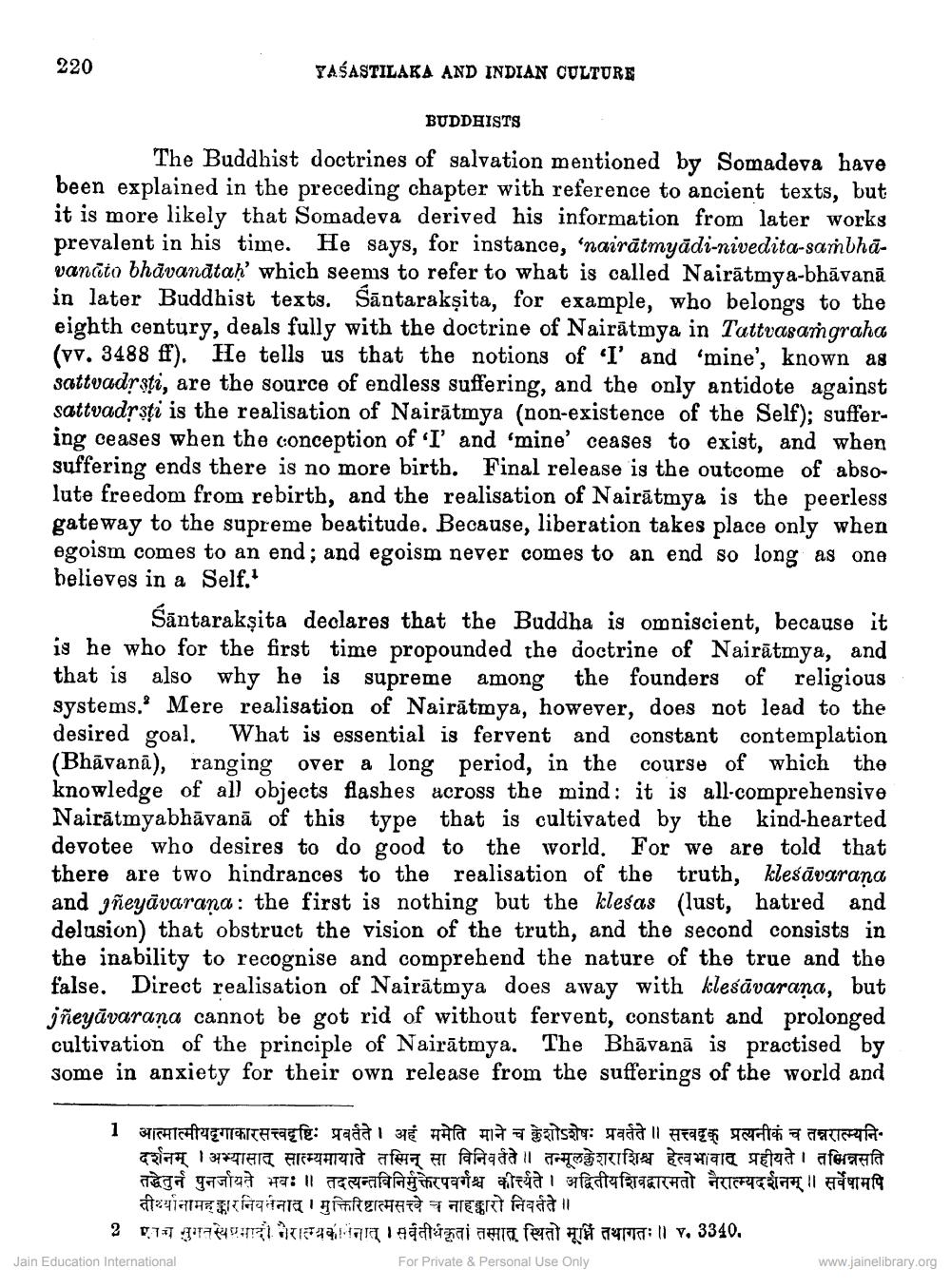________________
220
YASASTILAKA AND INDIAN CULTURE
BUDDHISTS The Buddhist doctrines of salvation mentioned by Somadeva have
explained in the preceding chapter with reference to ancient texts, but it is more likely that Somadeva derived his information from later works prevalent in his time. He says, for instance, 'nairātmyādi-nivedita-sambhāvanāto bhāvandtah' which seems to refer to what is called Nairātmya-bhāvanā in later Buddhist texts. Sāntarakṣita, for example, who belongs to the eighth century, deals fully with the doctrine of Nairātmya in Tattvasaņgraha (vv. 3488 ff). He tells us that the notions of 'I' and 'mine', known as sattvadrati, are the source of endless suffering, and the only antidote against sattvadrsti is the realisation of Nairātmya (non-existence of the Self); suffering ceases when the conception of I' and 'mine' ceases to exist, and when suffering ends there is no more birth. Final release is the outcome of absolute freedom from rebirth, and the realisation of Nairātmya is the peerless
eway to the supreme beatitude. Because, liberation takes place only when egoism comes to an end; and egoism never comes to an end so long as one believes in a Self.
śāntarakṣita declares that the Buddha is omniscient, because it is he who for the first time propounded the doctrine of Nairātmya, and that is also why he is supreme among the founders of religious systems. Mere realisation of Nairātmya. however, does not lead desired goal. What is essential is fervent and constant contemplation (Bhāvanā), ranging over a long period, in the course of which the knowledge of all objects flashes across the mind: it is all-comprehensive Nairātmyabhāvanā of this type that is cultivated by the kind-hearted devotee who desires to do good to the world. For we are told that there are two hindrances to the realisation of the truth, klešāvara and iñeyāvarana: the first is nothing but the klesas (lust, hatred and delusion) that obstruct the vision of the truth, and the second consists in the inability to recognise and comprehend the nature of the true and the false. Direct realisation of Nairātmya does away with klesāvarana, but jñeyāvarana cannot be got rid of without fervent, constant and prolonged cultivation of the principle of Nairātmya. The Bhāvanā is practised by some in anxiety for their own release from the sufferings of the world and
1 आत्मात्मीयदृगाकारसत्त्वदृष्टिः प्रवर्तते । अहं ममेति माने च केशोऽशेषः प्रवर्तते ॥ सत्त्वदृक् प्रत्यनीकं च तन्नराम्यनि
दर्शनम् । अभ्यासात् सात्म्यमायाते तस्मिन् सा विनिवर्तते ॥ तन्मूलक्लेशराशिश्च हेत्वभावात् प्रहीयते। तमिन्नसति तद्धेतुर्न पुनर्जायते भवः ॥ तदत्यन्तविनिमुक्तरपवर्गश्च कीर्त्यते । अद्वितीयशिवद्वारमतो नराम्यदर्शनम् ।। सर्वेषामपि तीर्थ्यानामह द्वारनिवर्तनात् । मुक्तिरिष्टात्मसत्त्वे च नाहकारो निवर्तते ॥ 2 1.1.1 gram
Haralegalimai ana ferat af AT: 11 V, 3340. Jain Education International For Private & Personal Use Only
www.jainelibrary.org




